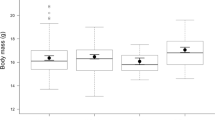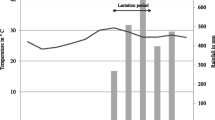Abstract
The Hamilton and Zuk hypothesis on haemoparasite-mediated sexual selection and certain studies of fitness are based on the assumption that blood parasite infections are detrimental to their hosts. However, there are few reports that have demonstrated harmful effects of endemic blood parasites on fitness in wild populations, and it has even been suggested that they may be non-pathogenic. In this paper, we show that individuals of the Australian sleepy lizard (Tiliqua rugosa) have smaller home ranges when they are infected with the haemogregarine blood parasite Hemolivia mariae than when no infection can be detected. An apparently contradictory result was that lizards with larger home ranges were more susceptible to infection under experimental exposure to Hemolivia. We propose that lizards sacrifice defence against pathogens by increased activity, perhaps associated with maintaining home ranges and mating opportunities. As a consequence, they gain higher parasite loads, which in turn inhibit their activity. In this case, the parasite–host interaction may act as a buffer of lizard activity.



Similar content being viewed by others
References
Anderson RM, May RM (1982) Coevolution of hosts and parasites. Parasitology 85:411–426
Anderson RM, May RM (1991) Infectious disease of humans: dynamics and control. Oxford University Press, Oxford
Andersson M (1994) Sexual selection. Princeton University Press, Princeton NJ
Bull CM (1988) Mate fidelity in an Australian lizard Trachydosaurus rugosus. Behav Ecol Sociobiol 23:45–49
Bull CM (1994) Population dynamics and pair fidelity in sleepy lizards. In: Vitt LJ, Pianka ER (eds) Lizard ecology: historical and experimental perspectives. Princeton University Press, Princeton, NJ, pp 159–174
Bull CM (1995) Population ecology of the sleepy lizard, Tiliqua rugosa, at Mt Mary, South Australia. Aust J Ecol 20:393–402
Bull CM, Burzacott D (1993) The impact of tick load on the fitness of their lizard hosts. Oecologia 96:415–419
Bull CM, Burzacott DA (2001) Temporal and spatial dynamics of a parapatric boundary between two Australian reptile ticks. Mol Ecol 10:639–648
Bull CM, Freake MJ (1999) Home range fidelity in the Australian sleepy lizard, Tiliqua rugosa. Aust J Zool 47:125–132
Bull CM, Pamula Y (1996) Sexually dimorphic head sizes and reproductive success in the sleepy lizard Tiliqua rugosa. J Zool 240:511–521
Bull CM, Cooper SJB, Baghurst BC (1998) Social monogamy and extra-pair fertilization in an Australian lizard, Tiliqua rugosa. Behav Ecol Sociobiol 44:63–72
Bull CM, McNally A, Dubas G (1991) Asynchronous seasonal activity of male and female sleepy lizards, Tiliqua rugosa. J Herpetol 25:426–441
Combes C (1997) Fitness of parasites: pathology and selection. Int J Parasitol 27:1–10
Dunlap KD, Schall JJ (1995) Hormonal alterations and reproductive inhibition in male fence lizards (Sceloporus occidentalis) infected with the malarial parasite Plasmodium mexicanum. Physiol Zool 68:608–621
Goater CP, Holmes JC (1997) Parasite-mediated natural selection. In: Clayton D, Moore J (eds) Host–parasite evolution: general principles and avian models. Oxford University Press, Oxford, pp 9–29
Hamilton WD, Zuk M (1982) Heritable true fitness and bright birds: a role for parasites? Science 218:384–387
Hillgarth N, Wingfield JC (1997) Parasite-mediated sexual selection: endocrine aspects. In: Clayton DH, Moore J (eds) Host–parasite evolution. Oxford University Press, Oxford, pp 78–104
Kerr GD, Bull CM (2002) Field observations of aggressive encounters between male sleepy lizards Tiliqua rugosa. Herpetol Rev 33:24–26
Kerr GD, Bull CM (2006a) Movement patterns in the monogamous sleepy lizard (Tiliqua rugosa): effects of gender, drought, time of year and time of day. J Zool 269:137–147
Kerr GD, Bull CM (2006b) Exclusive core areas in overlapping ranges of the sleepy lizard, Tiliqua rugosa. Behav Ecol 17:380–391
Main AR, Bull CM (2000) The impact of tick parasites on the behaviour of the lizard Tiliqua rugosa. Oecologia 122:574–581
Merino S, Moreno J, Sanz JJ, Arriero E (2000) Are avian blood parasites pathogenic in the wild? A medication experiment in blue tits (Parus caeruleus). Proc R Soc Lond B Biol Sci 267:2507–9510
Oppliger A, Celerier ML, Clobert J (1996) Physiological and behaviour changes in common lizards parasitized by haemogregarines. Parasitology 113:433–438
Ots I, Hõrak P (1998) Health impact of blood parasites in breeding great tits. Oecologia 116:441–448
Price PW (1980) Evolutionary biology of parasites. Princeton University Press, Princeton, NJ
Schall JJ (1983) Lizard malaria: parasite–host ecology. In: Huey RB, Pianka ER, Schoener TW (eds) Lizard ecology: studies of a model organism. Harvard University Press, Cambridge, MA, pp 84–100
Schall JJ (1986) Prevalence and virulence of a haemogregarine parasite of the Aruban whiptail lizard, Cnemodophorous arubensis. J Herpetol 20:318–324
Schall JJ (1996) Malarial parasites of lizards: diversity and ecology. Adv Parasitol 37:255–333
Scott ME, Smith G (1994) Parasitic and infectious diseases: epidemiology and ecology. Academic, San Diego
Sheldon BC, Verhulst S (1996) Ecological immunology: costly parasite defences and trade-offs in evolutionary ecology. Trends Ecol Evol 11:317–321
Smallridge CJ (1998) Studies on a haemogregarine parasite of the Australian skink, Tiliqua rugosa. Ph.D. thesis, Flinders University of South Australia, Adelaide
Smallridge CJ, Bull CM (1999) Transmission of the blood parasite Hemolivia mariae between its lizard and tick hosts. Parasitol Res 85:858–863
Smallridge CJ, Bull CM (2001) Prevalence of infection by the protozoan, Hemolivia mariae, in ticks. Parasitol Res 87:169–172
Smallridge CJ, Paperna I (1997) The tick transmitted haemogregarinid of the Australian sleepy lizard, Tiliqua rugosa belongs to the genus Hemolivia. Parasite 4:359–363
Sorci G, Clobert J (1995) Effects of maternal parasite load on offspring life-history traits in the common lizard (Lacerta vivipara). J Evol Biol 8:711–723
SPSS (2001) SPSS 12.0.1. SPSS, Chicago, IL
Weatherhead PJ, Barry FE, Brown GP, Forbes MR (1995) Sex ratios, mating behavior and sexual size dimorphism of the northern water snake, Nerodia sipedon. Behav Ecol Sociobiol 36:301–311
Wiehn J, Korpimaki E, Bildstein KL, Sorjonen J (1997) Mate choice and reproductive success in the American kestrel: a role for blood parasites. Ethology 103:304–317
Acknowledgement
This research was funded by grants from the Australian Research Council (to CMB) and from the Dutch ‘Amsterdamse Universiteits Vereniging Fonds’ (to MB). We are grateful to the landholders of the study area for their tolerance and hospitality and particularly to Clem and Ruth Jaensch and Ron and Leona Clarke, successive owners of Bundey Bore Station. We thank Dale Burzacott for help in the field and Steph Menken, Niels Dingemanse, Maarten Loonen and Joost Tinbergen for constructive comments on the manuscript. The study was conducted according to the guidelines of the Flinders University Animal Welfare Committee, in compliance with the Australian Code of Practice, for the use of animals for scientific purposes.
Author information
Authors and Affiliations
Corresponding author
Rights and permissions
About this article
Cite this article
Bouma, M.J., Smallridge, C.J., Bull, C.M. et al. Susceptibility to infection by a haemogregarine parasite and the impact of infection in the Australian sleepy lizard Tiliqua rugosa . Parasitol Res 100, 949–954 (2007). https://doi.org/10.1007/s00436-006-0379-5
Received:
Accepted:
Published:
Issue Date:
DOI: https://doi.org/10.1007/s00436-006-0379-5




